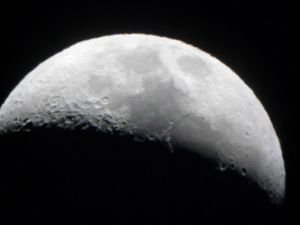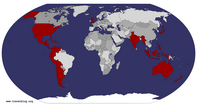Advertisement
Published: October 17th 2007

 The Moon
The Moon
Looking very big and sexy. I took this with my own SLR. How did I get this close to the moon? With some very large stepladdersI apologise in advance for this entry, as it might get a bit technical shortly. If you have no interest in astronomy, globular clusters, radio telescopes, or theories of extraterrestrial life, then skip to the next chapter. However, if you are a budding astronomy geek like myself (recently converted!), then please read on.
Our next stop was Chile, and as we crossed the border our shoes had to be disinfected, to prevent bringing certain pests into the country. You see, part of Chile's prolific success with wines is that it's the only country in the world to be free of the two main crop-destroying pests: downy mildew and root louse. If you add into the equation 250+ days of sunshine per year, cooling winds from the Pacific Ocean, and no rain during harvest season, you get one of the best growing conditions in the world, and some of the best wines! So Theresa, Steve and myself dedicated our first few days in Chile to trying as many of these fine wines as we could. It was hard work, as you can probably imagine, but we stuck with it. We had settled in the small town of San Pedro de Atacama,

 tools of the trade
tools of the trade
If you wanna be an astronomer, buy one of these off e-bayand apart from our wine sampling chores, we took a trip out to the desert for some stargazing. The Atacama Desert has one of the best conditions for astronomy on the face of the planet, for a number of reasons
1. It is high-altitude which means that the atmosphere is thinner and clearer
2. There is practically no light pollution or radio inteference from nearby cities
3. It has a very high proportion of cloudless nights per year
There are a number of hi-tech observatories in the area, such as America's multi-million dollar telescope known as the VLT (Very Large Telescope) I kid you not. They spent a fortune on this baby, and couldn't come up with a better name than "Very Large Telescope". Other state-of-the-art telescopes around the world include the EVLA (Expanded Very Large Array) and my personal favourite, the E-ELT (European Extremely Large Telescope). Yes, these do exist! In an attempt to redeem themselves and come up with a better name, the USA have spent another billion dollars building the "Atacama Large Millimeter Array" (ALMA). Approximately 10% of the budget was spent coming up with the name alone. But despite still having a lame name,

 indoor bonfires
indoor bonfires
this is usual in San Pedro barsthis is a very impressive piece of kit. It is a joint project between Chile, USA, Canada and Japan, and won't even be finished until 2012. Apparently it is being built by the same company that built Wembley Stadium. So what is special about it? Well, it is composed of 64 separate antennas, which are each twelve metres across and weigh 115 tons. Big buggers. Each one will be movable via a huge heavy hauler truck, and the spacings between them will be between 150 metres and 14km. So what will it be used for? I don't actually know, but it all sounds very impressive. (although I am disappointed they didn't use the name I emailed to them, which was RHT - Ridiculously Huge Telescope)
Our night began at 10:30, when we were driven out to the desert to a spot where five telescopes had been set up. These telescopes were of various size and design, but each of them looked like they could have fired a small missile. Each had been focused on a separate part of the sky. One was targeted on the moon, which as it turns out, is not made of cheese at all. That
telescope had a special lens for taking photos, hence my cool moon picture at the top. Once we had observed the sights in each telescope, they were re-aligned to another amazing part of the sky. We saw a binary star system, a globular cluster, a nebula, a blue giant, and an emerging star system. But my favourite one was the aftermath of a supernova, where you could clearly see a ring of scattered particles around where the star used to be.
Our guide for the evening was an extremely knowledgable German astronomer. There was no question he couldn't answer. (although I was tempted to ask him "why is abbreviation such a long word?"). He used a laser pointer to outline the main constellations, and to be honest, it's a real stretch of the imagination to see most of them. Even he agreed the ancient astronomers must have been smoking something when they named them. It was interesting to hear about the Zodiac signs. I knew there were twelve of them, I knew they are constellations, and I knew they are related to when you are born. But I never really thought about how they "worked". Do you know? Or

 a giant leap for mankind
a giant leap for mankind
in the Valley of the Moonis it only me that is the Zodicac dunce? Basically, as the earth revolves around the sun, the stars that we see at night are constantly changing. You will see a different night sky in Summer than you would in Winter. Of the twelve Zodiac signs, only one of them can be seen completely at any one time. As the Earth moves around the sun, one disappears and another one comes into view. The one which is completely in view when you are born is your star sign. Simple eh?
Now then, our next lesson is about the size of the universe. It's pretty damn large, to say the least. On the tour, our guide made us realise just how large the universe is. Our nearest star, apart from our beloved sun, is Alpha Centauri at a distance of 4 light years. So even if we could travel at the speed of light, it would take us four years to reach there. (I don't know about you, but an 18-hour flight to Australia is a right pain in the arse. A four-year flight would simply be unacceptable, even with Quantas). Now how far away do you think the furthest

 Giant Sand Dunes
Giant Sand Dunes
in the Valley of the Deadgalaxy is that we know of so far. 1,000 light years? A million light years? Not even close. The furthest is over 13,000 MILLION light years away!!!
And what about other life out there in the universe. Does it exist? Statistically, the answer is YES, without a doubt. When you look up into the sky, every star you see is a potential solar system like our own, with any number of orbiting planets. Some planets will be too far away from their sun, and will be too cold to support life. Others will be too close and will be too hot. But consider this. In our galaxy alone, there are 190,000 stars. The estimated number of galaxies is 125 billion. Somewhere, statistically, there WILL be other planets with the ideal conditions for life to develop. If fact, it's not a case of whether it could happen, but more a case of how many such planets are out there! We are not alone.
So, onto other topics. I have said that Chile has some of the best wine on the planet. It has the best conditions for astronomy. It also has the worst restaurant service ever. We were in

 Waiting for Sunset
Waiting for Sunset
Myself, Steve and Theresa waiting for the sun to move it's lazy ass behind the mountaina restaurant one night, and waited 15 minutes to be even given a menu. Sensing a certain slowness, we immediately ordered drinks before he could wander off, and.... nothing. Five minutes passed, no drinks. Ten minutes, not even a sniff of beverage, or the merest hint of service. The thing was, we were the only people in the restaurant! What was this guy doing? We were about to walk out when he ambled over after twenty minutes with the wine. I have seen glaciers move faster than this guy. Luckily the quality of the wine partly compensated for the disgraceful service. It was ETW (Exceptionally Tasty Wine). We talked about the lack of tip he would be getting, and stumbled upon a genius idea for tipping. A points system! Establish a maximum tip, say $5. Every bad action by the waiter brings his score down, and hence the tip down. Not being greeted cordially and cheerfully scores -1. Not bringing the drinks within five minutes scores -1. Not bringing withing ten minutes scores -3. Spilling red wine whilst pouring scores -1. Getting the food order right does not score any plus points, because this is expected. But getting the food

 shadows
shadows
looking tall for a changeorder wrong scores -5. Any attitude or surliness at being asked to take a wrong order back would incur a further -5 penalty. Apologising for the wrong order might bring back a +3 in his favour. You get the idea. The food here was exceptional though. For starters I had another "new food", namely Conger eel. It was served in a soup and was a very meaty fish, more so than even monkfish. Yum!!!! After the meal we hit a few bars for some light beers and banter. Most of the bars in San Pedro have a similar feature - bonfires! This part of Chile is hot during the day, and cold at night, but also has almost no rainfall. So most of the bars are open air once you get through the front door, and have small yet perfectly formed bonfires roaring away. What a magnificent idea! Sitting round an open fire, looking up at the stars. I can think of no finer way to enjoy a beer (apart from maybe sitting in a hot-tub with Miss Universe on one side and Miss World on the other).
Apart from stargazing, fine dining and pyromania, San Pedro has many

 Lovely Sunset
Lovely Sunset
Valley of the Moonother activities in the area. In fact, I have seldom been to a place where there are so many great places to visit nearby. We spent an afternoon cycling through "Devil's Gorge", a manic series of twisting channels through a devilish sandstone landscape. We had to carry our bikes over some parts, but it was all good wholesome fun. Other places included the Valley of the Dead, and the Valley of the Moon. Not much exciting to say about them, so I'll just post a few photos so you can admire their natural gorgeousness!
Advertisement
Tot: 0.085s; Tpl: 0.013s; cc: 12; qc: 28; dbt: 0.0489s; 1; m:domysql w:travelblog (10.17.0.13); sld: 1;
; mem: 1.1mb










Tim ruddock
non-member comment
VLT
Why not call the VLT Dave? Shame you forgot to focus when you shot the moon Pete :-)